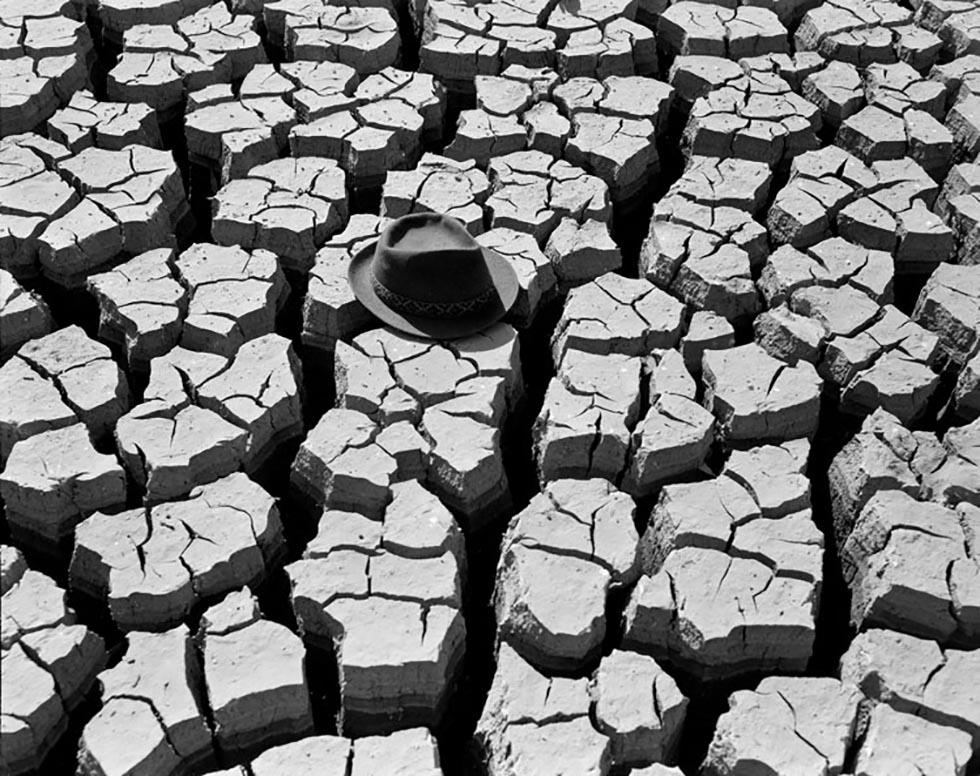


About this record
This black-and-white photograph shows the parched, cracked earth of the empty Burrinjuck Dam in the upper catchment of the Murrumbidgee River in southern central New South Wales. A man’s hat has been placed in the photograph to give us an idea of the size of the cracks. Australian News and Information Bureau photographer William ‘Bill’ Pedersen took the photograph on 19 March 1968.
Educational value
- This photograph shows the effects of drought on Burrinjuck Dam in 1968. Two years earlier, rainfall in the area had been more than double what it was in 1968 and water in the dam had been up to 45 metres deep. At the time of the photograph, however, Burrinjuck was down to 3 per cent of its storage capacity. The dam floor—exposed for the first time since the dam opened in 1927—was riddled with cracks up to a metre deep, which moved when walked upon.
- Farmers who rely heavily on irrigation systems feel the effects of drought almost immediately, but water shortages inevitably affect the whole nation. Stock and crop losses can lead to farm closures, and this can push up prices for farm goods across the country. The drop in productivity can also reduce Australia’s export income. This was evident in the 1967–68 drought: when the wheat harvest dropped by 40 per cent, 20 million sheep died and farmers lost some $500 million.
- Burrinjuck Dam was created in response to the 1895–1903 drought (often referred to as the ‘Federation drought’). It was the first major irrigation reservoir in New South Wales and it has been integral to the Murrumbidgee Irrigation Area (MIA) in the Riverina since 1912, when it was only partially completed. Enlarged in 1957, Burrinjuck now has a storage capacity of 1026 gigalitres (twice the volume of Sydney Harbour) and a catchment area of 12,953 square kilometres.
- Despite the severity of the 1967–68 drought, agricultural production in south-eastern Australia was higher than expected. Farmers had helped to achieve this in several ways: they moved livestock to areas where water was more plentiful; they transported fodder to drought-affected areas; and they controlled the rabbit population, which helped increase the amount of pasture for grazing animals.
- Australia’s variable rainfall, combined with global warming, means that water shortages will continue to be a fact of life for those living and working on the land. Many farmers have taken up more sustainable agricultural practices that can maintain productivity while protecting river systems, soil and native flora and fauna. Better understanding of the causes of climate fluctuations is also helping government and growers to better prepare for drought in one of the world’s driest continents
- This photograph was taken for the Australian News and Information Bureau (ANIB), which created photographic and written material primarily to promote Australia overseas. ANIB photographs provide a snapshot of life in Australia between 1950 and 1971, documenting everything from rural and urban communities to arts, sport, politics, flora and fauna, building and construction, mining, manufacturing, agriculture, fisheries and food production.
Acknowledgments
Learning resource text © Education Services Australia Limited and the National Archives of Australia 2010.
Related themes
Need help with your research?
Learn how to interpret primary sources, use our collection and more.


